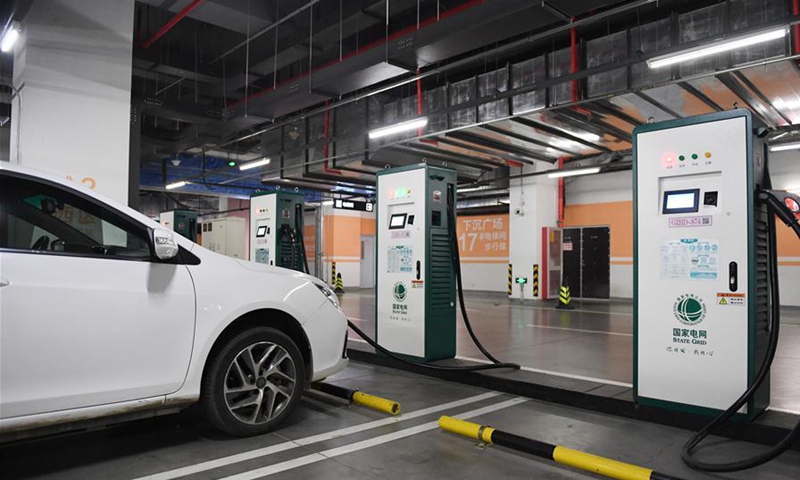
An electric vehicle is connected to one of the charging points at an electric vehicle charging station in the underground parking lot of the Wukesong sports center in Beijing, capital of China, May 16, 2020. File Photo: Xinhua
China has vowed to build a high-quality charging infrastructure system by 2030, in order to support the development of the new-energy vehicle (NEV) industry and achieve the goal of reaching carbon neutrality.
On Monday, China's State Council released guidance that detailed five major targets in building a high-quality charging infrastructure system by 2030, with extensive coverage, moderate scale, reasonable structure and perfect functions basically completed.
Analysts said that the guidance was specifically released to support the development of the NEV industry in China.
"Charging piles and stations are crucial infrastructure to serve NEVs. The improvement in the charging infrastructure will allay the anxiety of consumers and NEV owners about charging their cars, which will boost NEV consumption," Zhang Xiang, visiting professor with the Engineering Department of Huanghe Science and Technology University, told the Global Times on Monday.
According to the guidance, efforts will be put into the optimization and improvement of the network. Convenient and efficient intercity charging networks and interconnected charging networks in urban agglomerations will be built, especially the charging infrastructure in road networks between key cities. The network will effectively meet people's needs for charging during travel.
In existing residential areas, the charging infrastructure in fixed parking spaces should be fully installed, and new residential areas should be fully equipped with charging infrastructure, read the guidance.
Efforts will also be made in improving the operation service level, which means that provinces are encouraged to build platforms for charging infrastructure supervision and operation service, and to standardize the charging infrastructure information management. Meanwhile, industry access conditions and management policies will be improved.
According to the guidance, China will vigorously promote the application of intelligent charging infrastructure and the intelligent transformation of the distribution network. The country will accelerate technology research, such as fast charging, high-power charging, intelligent charging and wireless charging, and continue to optimize the technical performance of batteries for electric vehicles (EVs).
The State Council said that it will implement the peak-valley time-of-use electric pricing policy. Power grid enterprises are encouraged to give priority to the construction of charging infrastructure in terms of power grid access and capacity increase.
Local governments are encouraged to establish operation subsidy standards linked to service quality, and increase subsidies for demonstration projects such as high-power charging.
By the end of 2022, there were more than 3,000 charging pile operators in China, according to statistics from the National Energy Administration (NEA).
China has built the world's largest and most widely distributed charging infrastructure network. EVs consumed more than 40 billion kilowatt-hours of electricity in charging in 2022, an increase of 85 percent year-on-year, said the NEA.
"Although China is now the largest country in the world in terms of the number of charging piles, it still cannot meet the needs of car owners. Now the ratio of charging piles to vehicles is about 3.4:1, which means a charging pile can provide service for approximately three cars. But this is not enough, and it is necessary to further increase the investment in charging piles," said Zhang.
In 2022, the number of NEVs in China reached 13.1 million, an increase of 67.13 percent year-on-year. In 2022, the charging infrastructure in China reached 5.2 million units, an increase of nearly 100 percent year-on-year, NEA data showed.
Global Times




